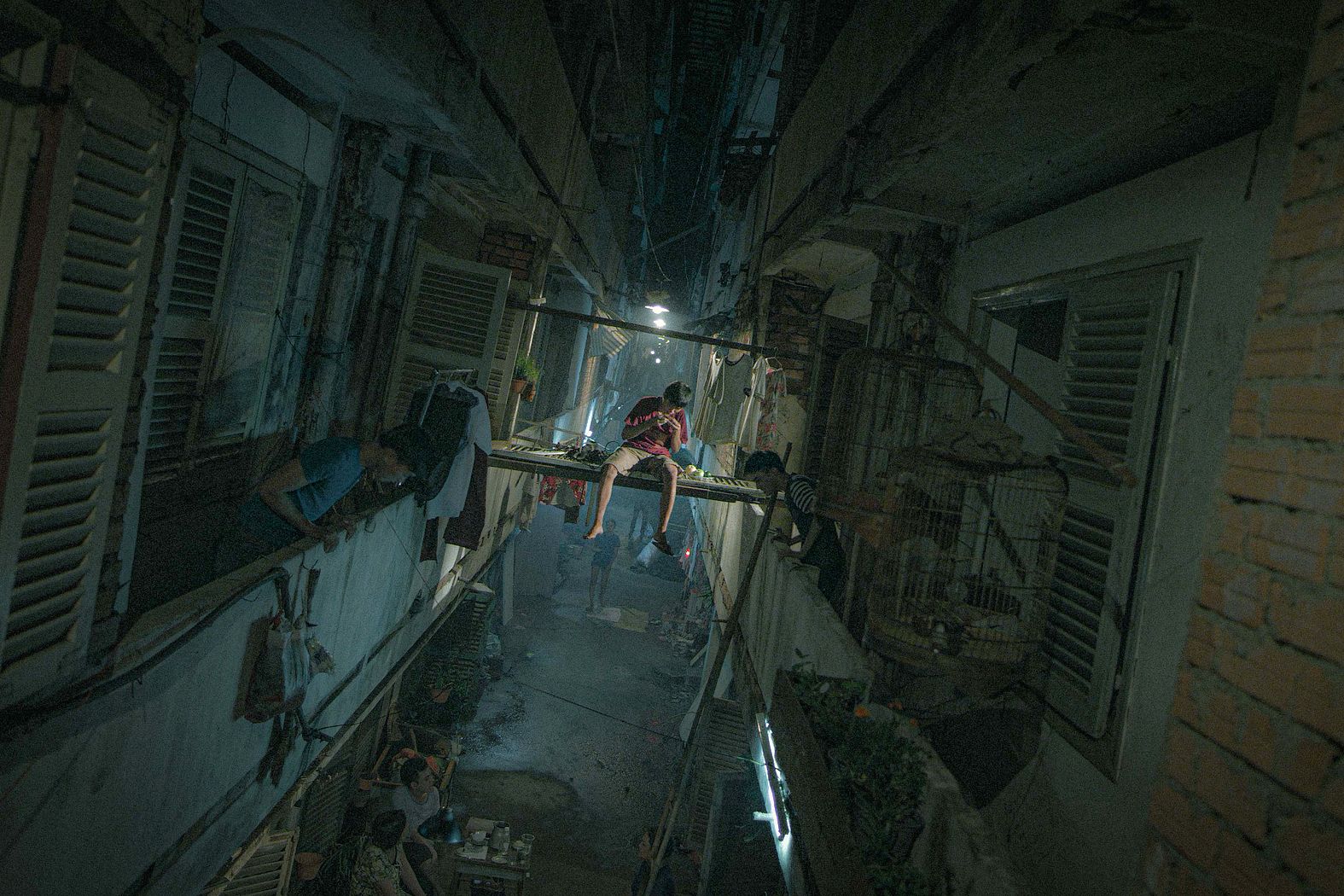As the screening came to an end, there were quiet sobs echoing softly across the auditorium. For a lot of us viewers with water in our eyes, it was a complete surprise that a documentary about a seemingly familiar subject matter like cải lương was capable of moving us so intensely.
Two weeks ago, Đoạn Trường Vinh Hoa (The Glorious Pain) had its Saigon premiere at the Institut d’Echanges Culturels avec la France (IDECAF) to a full house of eager audience members across ages, walks of life and hometowns. The documentary is the passionate personal project of director Lê Mỹ Cường and his co-creator Thanh Nguyễn. Both are no stranger to media productions, but this was their first foray into the specific documentary genre of direct cinema, striving for an honest, raw and realistic portrayal of the Mekong Delta’s cải lương tuồng cổ artists.

The Saigon premiere of the documentary even had to turn away late guests due to a lack of seats.
To make Đoạn Trường Vinh Hoa, the pair spent months embedded in the daily life of performers, technicians and artists of the traveling cải lương troupe Phương Ánh to record the most quotidian details of their routine. They ended up with 100 hours of footage that Cường had to sieve through and cut down to 30 hours to pass on to editors. The end result was 50 minutes of poignance filled with stellar cải lương stage performances, boisterous nhậu sessions, and intimate family moments that at times seem almost too private to play out on screen. Veteran singer Phương Ánh, the matriarch of the troupe, is the main emotional anchor of the documentary, along with her daughter Phương Anh (chị Hai), her son-in-law, and her grandson.

Veteran artist Phương Ánh is the titular matriarch of the troupe.
Approaching art with a clean slate and fresh mind is the ideal way to fully appreciate the works that artists have painstakingly crafted. Admittedly, I came to the premiere with my own set of assumptions about cải lương and the production. In Saigon, even if one doesn’t watch cải lương, there’s bound to be someone in their immediate circle — be it a grandparent, neighbor or a cordial auntie from the local tạp hóa — who always leaves a cải lương broadcast on all evening, even just as background noise. As a Saigon kid, my childhood was marked by the viscous vocal acrobatics of Kim Tử Long and Thanh Kim Huệ, even though I could barely understand or remember what they sang.
Cải lương is a distinctly southern performance art form that’s interwoven with generations of young and old Vietnamese in the Mekong Delta and nearby provinces, so there was a sliver of doubt in my mind upon learning that the documentary was produced by a crew from Hanoi. Cường, however, is aware of this personal shortcoming more than anyone. As he shared in the Q&A session after the screening, arriving in the Mekong Delta as a one-man crew was overwhelming for someone with little knowledge of cải lương and alone in a strange land. So he did the next best thing: asking Thanh Nguyễn to join him. At the time, Thanh was mainly doing photography and didn’t have much experience with documentary-making, but he agreed and flew down that night.

Director Lê Mỹ Cường filming a scene.
Having seen the fruits of their labor, I believe now that not only did they manage to overcome that setback, but also successfully transformed it into a strength. By diving headfirst into the scene sans predisposed beliefs, the filmmakers were able to approach cải lương with fresh eyes without falling prey to ingrained narratives. At the beginning, members of Phương Ánh also formed their own assumptions about Cường and Thanh after they expressed interest in documenting the troupe.
According to Cường, the artists are no newbies in the scene either, as numerous news channels and reporters have approached them to conduct short features about cải lương and then quickly left. Over the years, they’ve become well-versed in the art of media diplomacy, knowing what kind of polished answers to give and even offering Cường and Thanh pointers on how and when to conduct interviews. It was only after a few months of constantly seeing these two “loiter” around did they gradually realize that the filmmakers were after a different kind of video recording.

Troupe members preparing before a show at a village temple.
To achieve their vision for a non-staged, unscripted work of direct cinema, Cường and Thanh spent the first few months just forming a bond with members of the cải lương family to break down that wall on two sides of the lens. The efforts paid off, and what we observed on screen is a seamless integration of the viewpoint of the camera into the inner circle of a close-knit family. I can’t get out of my mind one moment in Đoạn Trường after chị Hai, the troupe’s female lead (đào chính), finishes an intense sequence on stage. She heads to a resting area backstage, removes her bedazzled accessories one by one, turns on a portable fan, and takes a nap, her breaths heavy and her eyes filled with ennui. It might appear to be a simple moment, but behind that simplicity is a rarely seen vulnerability that’s almost a direct contrast to the assertive, no-nonsense chị Hai shown at the beginning.

Putting on makeup and costumes before a show.
Without that established familiarity with the camera, the viewers might never get that prized glimpse into the physical toll that cải lương shows take on their performers. Over the course of its running time, The Glorious Pain rarely acknowledges the camera or employs talking heads, except for two key moments that perhaps carry the entire gravitas of the documentary, both interviews with Madam Phương Ánh. Most of the film takes place in real-time with minimal editorializing from either the characters or the filmmakers, a quality that I appreciate. It allows viewers to freely interpret and make their own judgement about the events unfolding before their eyes. There’s an endearing “meta” moment right at the start when Phương Ánh breaks the fourth wall by calling for Cường, who's filming, by name to ask him to move a trunk of stage equipment. She facetiously chastises herself for treating “these VTV boys” like her personal assistant.

Lê Mỹ Cường (middle) and Thanh Nguyễn (right) share many details of their filming process at the Saigon premiere on November 1.
The documentary’s climax comes suddenly and forcefully, like a punch in the face. It’s a complete coincidence, even Cường admitted, that they got to know the troupe at the right place and right time to be able to witness such a monumental moment. Nonetheless, the event and its aftermath had crucial bearing on Phương Ánh and the family, and moved us to tears. I will not deny you the privilege of seeing it yourself by spoiling it, but do yourself a favor and book a ticket right now.
Đoạn Trường Vinh Hoa has achieved many things outside of its initial goal to highlight a dying craft, but to me, it’s an impressive feat that has knocked down existing assumptions from all parties involved. The cải lương artists possessed their own assumptions about the filmmakers when they first met, which gradually faded away after months of living, working and bonding together. Phương Ánh herself professed a deep fondness for Cường and Thanh at the premiere. Each member of the audience came to the screening no doubt with their own assumptions about cải lương. I knew that cải lương artists have been struggling with making a living and passing down their passion in the modern era, but The Glorious Pain showed me just how superficial my understanding of their hardships was.


The striking difference between the glorious stage side and the behind the scenes.
I’ve always adored the “glorious” aspects of cải lương — the costumes, the satisfying finish after each elegantly enunciated sentences, the well-lit stage, and more — but its “pain” has never been depicted so vividly and physically as in Đoạn Trường Vinh Hoa. It’s not just an abstract yearning for more audience or ticket sales, it’s also a bodily hurt that slowly besmirches one’s flesh and bones, worsening with every late show, missed meal and month without enough income for nutritious food. Like the director shared at the premiere, the story portrayed in the documentary is special not merely because of how it unfolded — even though the journey of Phương Ánh's troupe was truly extraordinary to watch — but also in its universality. There are numerous cải lương artists also struggling to maintain their career while afflicted with sickness and poverty. And these issues are not limited to cải lương either: many traditional art forms and artisans also need help and attention.

Many viewers couldn't help but tear up during the screening.
Alas, documentary is not a popular genre in Vietnam, probably due to its limited commercial appeal in the eyes of production companies and the local audience’s unfamiliarity with the genre. Still, from Madam Phung’s Last Journey to Finding Phong to The Glorious Pain, the amount of attention they have generated has been exceedingly heartening. Like Finding Phong, Đoạn Trường Vinh Hoa has been approved for screening in select theaters due to popular demand and word of mouth.
Đoạn Trường Vinh Hoa is currently showing from November 13, 2020 in some BHD cineplexes in Hanoi, Saigon and Hue before airing on national television. Book your ticket here.















